

I.T. Solutions for Shipping Business: Profitability vs. Expansion: Shipping Software is Key for Survival in Container Shipping. Maritime shipping companies forecast rough sailing ahead due to a slump in global demand for container shipping and continuously increasing fuel prices.

Add to that the growing supply of new ships driving competition for cargo and freight rates to a critical level. With this, shipping companies are steering farther toward cost-cutting and maximizing profit, setting aside other considerations such as expansion in the meantime. As has been pointed out by experts repeatedly, implementing functional shipping solutions software plays a critical role in achieving this goal. Last year, A.P. Moller-Maersk, the world’s biggest container shipping company, warned of a slowing global trade in shipping. Whether it is good or bad news for the world’s leading container carrier, these results reflect the dire reality that shipping companies are struggling to stay in profit as a result of increasing costs of operation. I.T. Solutions for Shipping Business: Free Shipping Software Solutions: Bargain or False Economy? As the old saying goes, “there’s no such thing as a free lunch.”
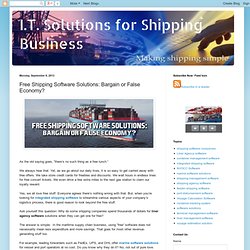
We always hear that. Yet, as we go about our daily lives, it is so easy to get carried away with free offers. We take store credit cards for freebies and discounts. We wait hours in endless lines for free concert tickets. We even drive a few extra miles to the next gas station to claim our loyalty reward. Yes, we all love free stuff. Ask yourself this question: Why do some shipping companies spend thousands of dollars for liner agency software solutions when they can get one for free?
The answer is simple: In the maritime supply chain business, using “free” software does not necessarily mean less expenditure and more savings. For example, leading forwarders such as FedEx, UPS, and DHL offer marine software solutions for vessel and port operators at no cost. Here’s what happens when you settle on free software instead of going for more reliable liner principal software: So, here’s your takeaway:
I.T. Solutions for Shipping Business: How Liner Agency Software Helps in Reducing Greenhouse Gas Emission. About 5% of the world’s greenhouse gas (GHG) emissions come from merchant vessels.
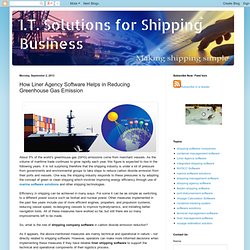
As the volume of maritime trade continues to grow rapidly each year, this figure is expected to rise in the following years. It is not surprising therefore that the shipping industry is under a lot of pressure from governments and environmental groups to take steps to reduce carbon dioxide emission from their ports and vessels. I.T. Solutions for Shipping Business: A Caveat on Implementing Shipping Software Solutions. As marine shipping requirement change, shipping companies are always on the lookout for best possible maritime logistics solutions.
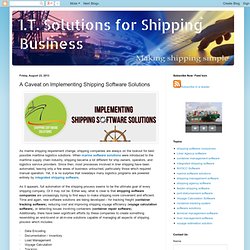
When marine software solutions were introduced to the maritime supply chain industry, shipping became a lot different for ship owners, operators, and logistics service providers. Since then, most processes involved in liner shipping have been automated, leaving only a few areas of business untouched, particularly those which required manual operation. Yet, it is no surprise that nowadays many logistics programs are powered entirely by integrated shipping software. As it appears, full automation of the shipping process seems to be the ultimate goal of every shipping company. Or it may not be. Additionally, there have been significant efforts by these companies to create something resembling an end-to-end or all-in-one solutions capable of managing all aspects of shipping process which includes: · Data Encoding · Documentation / Inventory · Load Management.
I.T. Solutions for Shipping Business: Integrated Shipping Software: Tips for Reducing Fuel Consumption. Fuel consumption accounts for between 50 t0 60 percent of the cost of running a container vessel.
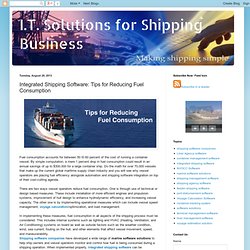
By simple computation, a mere 1 percent drop in fuel consumption could result in an annual savings of up to $300,000 for a large container ship. Do the math for over 70,000 vessels that make up the current global maritime supply chain industry and you will see why vessel operators are placing fuel efficiency alongside automation and shipping software integration on top of their cost-cutting agenda. There are two ways vessel operators reduce fuel consumption. One is through use of technical or design based measures. These include installation of more efficient engines and propulsion systems, improvement of hull design to enhance hydrodynamic efficiency, and increasing vessel capacity.
I.T. Solutions for Shipping Business: Which Shipping Software Solution Is Right for You? It is well-documented: shipping software significantly improves the process of moving goods between ports and terminals.
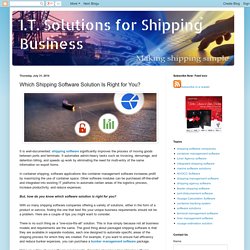
It automates admin-heavy tasks such as invoicing, demurrage, and detention billing, and speeds up work by eliminating the need for multi-entry of the same information on export forms. In container shipping, software applications like container management software increases profit by maximizing the use of container space. Other software modules can be purchased off-the-shelf and integrated into existing IT platforms to automate certain areas of the logistics process, increase productivity, and reduce expenses. But, how do you know which software solution is right for you? With so many shipping software companies offering a variety of solutions, either in the form of a product or service, finding the one that best fits your unique business requirements should not be a problem.